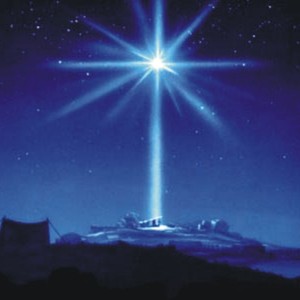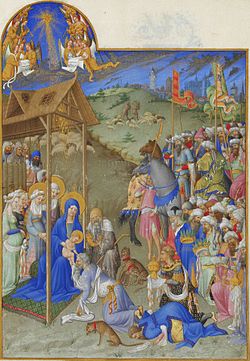Star of Bethlehem I

Star of Bethlehem I
Star of the Birth of Christ
 Star of Bethlehem according to Christian tradition, was the star that guided the Magi to the birthplace of Jesus Christ. The Gospel of Matthew mentions that the Magi in the West saw the Star of Bethlehem, but was not clear if it was a planet, a star or other astronomical phenomenon of astrology. According to the writings, the wise men following the star traveled, and it stopped over the place where Jesus was born. Although it is impossible for a star to mark a place as specific as a manger and there have been various suggested explanations for this fact, it is likely that the passage is only a metaphor for the alleged facts. Whatever it was, the Wise Men were associated with King of the Jews. If they were Greek or Roman astrologers, they would have associated the star of Bethlehem with Jupiter, the planet king, and Regulus, the star king. If they came from Babylon, they could have associated the planet Saturn (Kaiwanu). In any case, it could also be the star Sirius, which suggests the "three kings" of the belt of the constellation Orion.
Star of Bethlehem according to Christian tradition, was the star that guided the Magi to the birthplace of Jesus Christ. The Gospel of Matthew mentions that the Magi in the West saw the Star of Bethlehem, but was not clear if it was a planet, a star or other astronomical phenomenon of astrology. According to the writings, the wise men following the star traveled, and it stopped over the place where Jesus was born. Although it is impossible for a star to mark a place as specific as a manger and there have been various suggested explanations for this fact, it is likely that the passage is only a metaphor for the alleged facts. Whatever it was, the Wise Men were associated with King of the Jews. If they were Greek or Roman astrologers, they would have associated the star of Bethlehem with Jupiter, the planet king, and Regulus, the star king. If they came from Babylon, they could have associated the planet Saturn (Kaiwanu). In any case, it could also be the star Sirius, which suggests the "three kings" of the belt of the constellation Orion.
Throughout history, many people have tried to find out about what is the real meaning of star of the Magi: was the star a natural event that really happened, or was it merely an assigned myth of a spiritual nature, or even a real sign of supernatural nature of vital importance to determine the birth of Jesus Christ.
The presence of a Star of Bethlehem at the birth of Jesus is no doubt a messianic symbol. The Biblical reference is the prophecy of the star of Balaam, which was to be received through the line of Jacob. Although the star has often been identified with King David, even before the birth of Christ, the Jews were still waiting for the Messiah.
“I see him, but not now;
I behold him, but not near.
A star will come out of Jacob;
A scepter will rise out of Israel.”
~ Numbers 24:17
 In the second century, Origen Adamantius and Irenaeus of Lyons recalled this prophecy precisely about the Star of Bethlehem. Irenaeus particularly appealed in his books, to the prophecies to demonstrate the truthfulness of Christianity. The messianic identification is even more clear in the versions of the Bible (the translations normally used by Evangelists), where the "scepter," which is located in Israel, is translated into Greek as "man.”
In the second century, Origen Adamantius and Irenaeus of Lyons recalled this prophecy precisely about the Star of Bethlehem. Irenaeus particularly appealed in his books, to the prophecies to demonstrate the truthfulness of Christianity. The messianic identification is even more clear in the versions of the Bible (the translations normally used by Evangelists), where the "scepter," which is located in Israel, is translated into Greek as "man.”
As it occurred in the prophecy of Balaam, the theme of "light" appears in many other prophecies throughout the Bible which traditionally are applied to the Messiah.
“Arise; shine, for your light has come,
And the glory of the LORD rises upon you.
See, darkness covers the earth
and thick darkness is over the peoples,
but the LORD rises upon you
and his glory appears over you.
Nations will come to your light,
and kings to the brightness of your dawn.
~ Isaiah 60:1
The "nationalism" that pervades the prophecy of Balaam may be the reason why the Star of Bethlehem does not appear in the Gospel of Luke, directed to "gentle" Hellenized Jews.
Through the ages, astronomers have tracked the scriptural references to try to find a rational explanation for these episodes of the New Testament, trying to find our clues for the exact date of birth of Jesus Christ; and to determine if it was really possible to track what could have been an astronomical phenomena that may have coincided with time with the scriptures.
The monk Dionysius Exiguus[1], an astronomer and abbot of a Roman Scythian monastery responsible for establishing the birth of Jesus, made ??two significant errors in calculating the calendar in the sixth century, Christian. To determine the year of the birth of Christ took into account the reigns of Roman emperors but forgot that Caesar Augustus had ordered four years under the name of Octavio and the year zero omitted.
That margin of error places the birth of Jesus five years earlier than assumed. Besides these facts, there are two other references furnished by the Gospels which are useful to find the approximate date of the event revered by Christians.
- The census that forced Joseph and Mary to request lodging in Bethlehem could be what Caesar Augustus ordered between 8 and 6 BC. Additionally, according to scripture, King Herod, who ordered the death of male children hoping to eliminate the “King of the Jews” died in 4 BC.
- The Nativity probably did not happen in December. Luke the Evangelist says that the shepherds watched their flocks in the mountains, but in Bethlehem, in December, it was the time during which sheep would have been driven to town and during which, the sheep would have been grazing indoors and out. This data suggests that the birth of Jesus took place between March and April of year 6. BC.
In the Gospel of Luke, it says that the angel Gabriel appeared to Zechariah, father of John the Baptist when he ministered in the temple. Given this, we obtain the data, as was the order of Abijah, ministering the incense the penultimate week of May and John was born before Jesus, at least six months ahead. So, according to this, Jesus must have been born on the Feast of Tabernacles, in the month of September.
 On the other hand, if we take into account that in the Gospel of Luke and that the sixth month of the Jewish calendar for the month of Etul, 'August- September' to the Gregorian calendar, we can locate the moment of conception of Mary, hence the birth of Jesus nine months after "June" in the Gregorian calendar, also coincides with the summer solstice for the northern hemisphere, 21 June being the longest day of the year. This foundation is totally believable as based on a biblical and astronomical perspective.
On the other hand, if we take into account that in the Gospel of Luke and that the sixth month of the Jewish calendar for the month of Etul, 'August- September' to the Gregorian calendar, we can locate the moment of conception of Mary, hence the birth of Jesus nine months after "June" in the Gregorian calendar, also coincides with the summer solstice for the northern hemisphere, 21 June being the longest day of the year. This foundation is totally believable as based on a biblical and astronomical perspective.
In the sixth month of Elizabeth’s pregnancy, God sent the angel Gabriel to Nazareth, a town in Galilee, 27 to a virgin pledged to be married to a man named Joseph, a descendant of David.
~ Luke 1, 26-27
The Gospel of Luke mentions that the announcement was the sixth month of the Jewish calendar, i.e., in September, which is governed under the sign of Virgo (the Virgin) and a nine-month gestation would result in the virgin shine under the sign of Gemini, in June. Because of the above, one can conclude that Jesus was born in June, probably on the 17th (numerological 8 as the day of his resurrection and symbol of baptism) and analog in terms of interpretation allow us to affirm the dual nature of Christ, God and human, like Castor and Pollux in the constellation Gemini, in terms of Greek mythology.
[1] Dionysius Exiguus (Dennis the Small, Dennis the Little or Dennis the Short, meaning humble) (c.470 – c.544) was a 6th-century monk born in Scythia Minor, modern Dobruja shared by Romania and Bulgaria. He was a member of the Scythian monk's community concentrated in Tomis, the major city of Scythia Minor. Dionysius is best known as the inventor of the Anno Domini (AD) era, which is used to number the years of both the Gregorian calendar and the (Christianized) Julian calendar.









